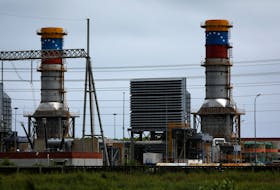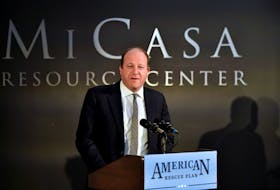Whether it’s a gale coming across Placentia Bay, a northeaster bearing down on the Bonavista Peninsula or an average day in Wreckhouse, Newfoundland and Labrador has an abundance of offshore wind.
But at present, the province is not harnessing the renewable and clean energy, and there is myriad of reasons why.
First and foremost, the province’s own power needs are already being met and the province is already a net exporter of power and will be exporting more once Muskrat Falls comes online.
So even if all this untapped power were harnessed, where would it go?
“Where is the business case for offshore wind produced in Newfoundland and Labrador? Who’s developing it? Is Nalcor on board? They’re a critical partner in all of this because of the way the legislation is right now. Where is the market? How is it getting there?” asks Erin Stapleton, director and principal at Stapleton Environmental Consulting.
“There absolutely are some very real challenges, but what is encouraging is that we’re finally starting to talk about these issues and at least we’re a little more informed to understand what is and isn’t possible and make our decisions accordingly.”
Stapleton served as the host for one such conversation Tuesday in St. John’s, an educational workshop on offshore wind energy markets and supply chains put off by the Newfoundland and Labrador Environmental Industries Association and Marine Renewables Canada.
As many questions and unknowns exist when talking about the possibility of large-scale projects here, there are also some very real advantages, starting with an existing and effective supply chain system already serving the needs of the province’s oil and gas sector.
Guest speaker Alan Duncan, owner and director of Scotland-based Scotia Supply Chain Ltd., says on an international stage some of the oil and gas industry’s major players, such as Statoil and Shell, are moving into offshore wind in Europe, and he believes Canada, and by extension this province, is well positioned to break into the industry.
“Is Shell going to start developing wind and develop a whole new supply chain from offshore wind suppliers they don’t know before or are they going to bring their existing supply chain of oil and gas suppliers that they can cherry pick … certain elements of an offshore wind farm which are almost identical to oil and gas,” Duncan said.
“I think the fact Canada’s well in with the super majors gives you a head start in terms of pre-qualification. As more oil and gas guys get into offshore wind, I think that’s how Canada will absolutely migrate over with their customers.”
With the cost to develop offshore wind dropping dramatically in recent years thanks largely to advances in technology, thereby creating competitive pricing in relation to other energy sources, Duncan says it’s a critical time for Canada to begin looking at making the most of its resource.
“Will it ever challenge the cost of hydro in Canada? I don’t know,” he says.
“If it did, I think you’ve got a really compelling case because the beauty of offshore wind is you can pretty much deploy this two or three miles from your major coastal cities.
“Fundamentally, in the next 10 years it will be the cheapest form of new energy generation around.”
That still doesn’t solve the question of who’s buying it.
John Dalton, president of Power Advisory, a management consulting firm that specializes in electricity sector matters and solutions, says the New England states, all of which have aggressive greenhouse gas reduction goals, are ideal targets.
“We’re anticipating that there will be about a 30 per cent reduction relative to 1990 levels, that’s below the commitment of 45 per cent reduction,” Dalton told the workshop via teleconference. “Additional programs and policies need to be put in place to achieve the emission reduction that the New England states have essentially committed to.”
Unfortunately, Newfoundland and Labrador is in its own control area — a power system or combination of systems wherein a common generation control scheme is applied — and needs to be in the Atlantic control area in order to qualify as a Class 1 resource under the recently established renewable portfolio standards program introduced in the New England states.
“However, it is possible for offshore wind from Newfoundland to qualify as clean energy in Massachusetts, (which) has recently developed a clean energy standard which is used to procure clean energy.
“Clean energy could be viewed as a lower quality form of resource which helps the state achieve its greenhouse emission targets, but is not expected to receive the same value as renewable energy.”
Transmitting that power is another challenge, as there’s no capacity left on the Maritime Link and, even if there were, there are added transmission costs cutting into profit margins, and the Maine transmission system is already highly congested.
And none of this takes into consideration the Muskrat Falls effect.
“Given the size of the project and the volume of energy produced there is considerable surplus, therefore that suggests that you need to consider that surplus when valuing energy that an offshore wind project would produce, and I think that adversely affects the value of energy produced by an offshore wind project,” Dalton said.
The workshop’s final session was presented by Jon Brady, a senior policy adviser in Natural Resources Canada’s renewable and electrical energy division, who detailed the emerging renewable power program (ERPP), the most recent federal program aimed at spending $200 million to foster the development of renewable and clean energy in an effort to reduce greenhouse gas emissions.
Stapleton says it’s encouraging to see Ottawa take a clear stance and seriously consider and endorse other renewable energies and not just hydroelectric.
“When it comes to offshore wind, I think it’s been a great way to draw attention to that particular sector because if the federal government is behind it, if there’s money there that can be leveraged, then that’s a little more encouraging to people who otherwise would be reluctant to engage.”
Twitter: kennoliver79









